Ikkeri
Ikkeri is situated in Sagara taluk about 6 km to the south of Sagara. The word Ikkeri in Kannada means "Two Streets".
Ikkeri | |
|---|---|
village | |
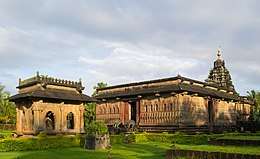 Aghoreshwara Temple, in Dravidian architecture, Keladi Nayaka period | |
 Ikkeri Location in Karnataka, India | |
| Coordinates: 14.1350°N 75.0226°E | |
| Country | |
| State | Karnataka |
| District | Sagara Shimoga |
| Government | |
| • Type | Panchayat raj |
| • Body | Gram panchayat |
| Languages | |
| • Official | Kannada |
| Time zone | UTC+5:30 (IST) |
| Telephone code | 08183 |
| ISO 3166 code | IN-KA |
| Vehicle registration | KA-15(Sagara) |
| Website | karnataka |
Nayakas of Ikkeri
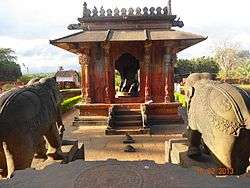
It was, from about 1560 to 1640 AD, the capital of the Nayakas of Keladi chiefs, afterwards removed to Bednur Nagara. Ikkeri continued, however to be the nominal capital, the Rajas were called by its name, and the coins were called Ikkeri Pagodas and Fanams, although, if fact, the mint was removed. Its walls were of great extent, forming three concentric enclosures. In the citadel was the palace, of mud and timber, adorned with carving and false gilding. The only vestige of its former greatness is the temple of Aghoreshvara a large and well proportioned stone-building. On the floor in front of the shrine are the effigies of three of the Keladi chiefs, doing obeisance, with the name inscribed above each. One of them, Huchcha (Supreme) Somasekhara, is represented as manacled and fettered. The distance between the central pillars was adopted as the standard measure for garden land. A rod of this length, equal to 18 feet 6 inches, was the space called daya allowed for one tree, and the shist was fixed on 1,000 such daya at various rates constructed in a mixed style with a unique conception.
Aghoresvara temple
The Aghoresvara temple above mentioned is a large structure, built of granite, in a uniquely mixed style that incorporates elements from Vijayanagara architecture, the Karnata Dravida style of the Later Chalukya dynasty and Hoysala Empire.
The temple faces north and has lofty roof and ornamental doorways on the west, north and east, the north doorway being the best with two elephants at the sides. The Garbhagriha, which is built of huge stones, contains a gigantic pedestal occupying nearly three-fourths of the whole space and sculptured all round with 32 seated female figures called Shakti Peetha. In the Sukhanasi is a small translucent Nandi (bull) carved out of white spar. The temple has no navaranga doorway there are two niches, those to the right containing the figures of Ganesha and Subramanya and those to the left figures of Mahishasuramardini and Bhairava.
There are intricate carvings on the stone walls of the temple. There are carvings & sculptures such as Temple Relief (sculpture consisting of shapes carved on a surface so as to stand out from the surrounding background), Erotica, Fingurine, Old Kannada Manuscript, Sculpted Elephant etc.
At present it is maintained by Archaeological Survey of India.
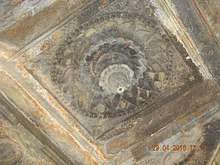
Gallery
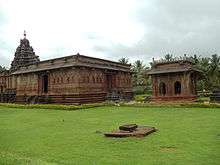 Aghoreshwara temple at Ikkeri
Aghoreshwara temple at Ikkeri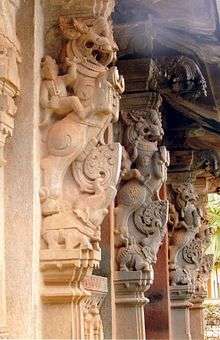 Yali pillars in Aghoreshwara temple at Ikkeri
Yali pillars in Aghoreshwara temple at Ikkeri Ikkeri temple Karnataka
Ikkeri temple Karnataka The wide and beautiful Aghoreshwara Temple
The wide and beautiful Aghoreshwara Temple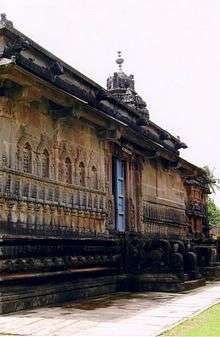 Profile of Aghoreshwara Temple
Profile of Aghoreshwara Temple
References
C.Hayavadana Rao, B.A., B.L., Fellow, University of Mysore, Editor, Mysore Gazetteer, 1930 Edition, Government Press, Bangalore.
B B Susheel Kumar, Founder and Photographer at © B B Susheel Kumar
See also
- Keladi
- Keladi Nayaka
- Vijayanagara Empire
- Karnataka
| Wikimedia Commons has media related to Ikkeri. |